Au dernier trimestre 2018, dans la revue 'Hommes et Plantes' N°107, est paru notre article traitant des Ginkgos. Nous vous livrons ici l'article complet original, qui a ensuite été adapté pour paraitre dans la revue du CCVS.
L’arbre aux quarante écus, aux quarante questions, aux quarante vertus.
Par Bénédicte NICOLAS – Les jardins du Florilège

Ginkgo biloba femelle de Geebets (Belgique) - Planté en 1753 lors de la construction du presbytère
 Le ginkgo biloba est une plante ancestrale. Elle apparait à l'époque des dinosaures, au Jurassique, il y a 170 millions d'années. On en connait des exemples fossiles dans tout l'hémisphère nord.
Le ginkgo biloba est une plante ancestrale. Elle apparait à l'époque des dinosaures, au Jurassique, il y a 170 millions d'années. On en connait des exemples fossiles dans tout l'hémisphère nord.
Actuellement, il persiste une poche de ces spécimens vivants, en Chine, ayant résisté aussi au morcellement massif des terres et à l'agriculture intensive apparue dans les années 50.
En 2012 des botanistes ont prouvé et attesté que ces sujets sont présents à l'état naturel et n'ont jamais été plantés par l'homme.
.jpg)
Ginkgo biloba de l'arboretum de Leiden - Hortus botanicus
Planté en 1788 - Sujet mâle doté d'une greffe femelle
Intrigant à plus d'un titre, le Ginkgo semble être proche des conifères. Même si son apparence pourrait laisser penser le contraire puisqu’il n’est pas vraiment de forme conique, surtout avec l’âge, et qu’il porte des feuilles caduques et non des épines persistantes. Il fait pourtant partie du groupe des plantes anémophiles gymnospermes, comme les conifères.
Les plantes anémophiles sont pollinisées par le vent, et non par les insectes, comme le sont les plantes entomophiles. Les plantes gymnospermes ne font pas de fleur ou de fruit car leurs organes reproducteurs se présentent complètement dénudés.
Zoom sur ses particularités morphologiques.
Généralement le Ginkgo a un port érigé, un tronc unique pouvant mesurer jusqu'à 2m de diamètre, est ramifié par de fortes branches obliques ou horizontales. Les rameaux plus petits offrent des bouquets de feuilles. Il peut atteindre 30m de haut, dans les meilleures conditions.

Cette plante, proche des conifères, a des "feuilles" plutôt que des aiguilles ou des écailles comme la toute grande majorité de ses compères. Il est caduc, caractéristique également minoritaire dans ce groupe végétal, partagée par les Larix, Pseudolarix, Metasequoia et Taxodium.
Si on observe, de façon plus précise, ses feuilles, on découvre qu'elles sont fondamentalement différentes de celles d'un arbre ou d'un arbuste, ou même d'une vivace. Elles ne sont pas « veinées » de la même façon.
Il s'agit, en réalité, d'une juxtaposition de plusieurs aiguilles, collées en éventail, unies sur un même pétiole. Il pourrait donc bien s'agir d'un conifère à épines ou une forme « évoluée ». Avec ce dispositif, le Ginkgo pratique bien mieux la photosynthèse.
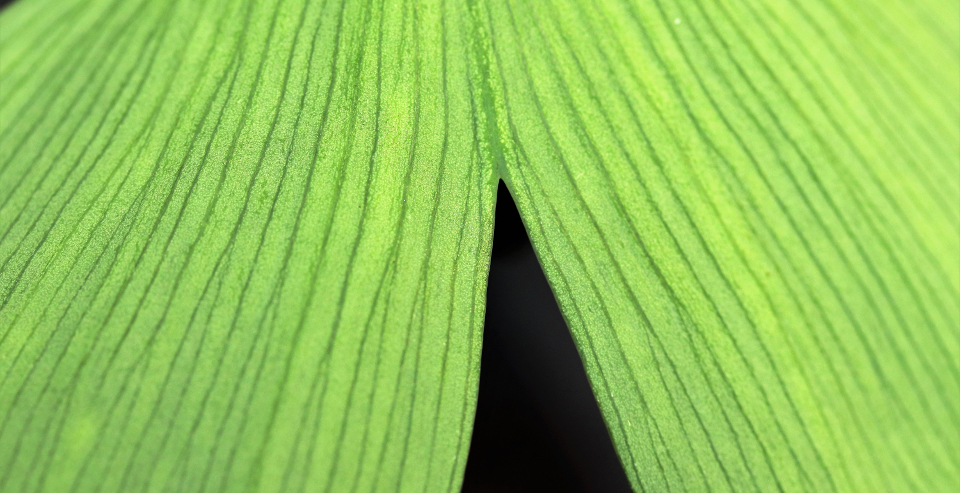
Une autre caractéristique unique et propre à ce genre végétal est la formation de « Chi-Chi », repris du japonais, signifiant « mamelles ».
.jpg)
Il s’agit d’excroissances tombantes, assimilées à des racines aériennes, formées à même l’écorce des vieux troncs. Elles apparaissent, en général, lorsque les conditions d’apport nutritif ne sont pas suffisantes.
L’arbre augmente sa surface d’écorce, afin d’augmenter le nombre de capteurs qui s’y trouvent et ainsi récupérer un maximum de substances nécessaires à son développement. « Il fait littéralement fondre et couler son écorce, comme la cire le long d’un cierge ».
Il adapte également son comportement, lors de la croissance des branches. Certaines retournent verticalement vers le sol, pour s’y enraciner, et pomper d’avantage d’eau et de nutriments dont la plante a besoin.
Classification du Ginkgo
Finalement, le Ginkgo, est-il, oui ou non, un conifère ?
Si on veut être précis et suivre pointilleusement la classification scientifique, la réponse est non.
Si on souhaite vulgariser l’information, et classer cette plante parmi les classiques « arbres, arbustes, conifère, vivaces, plantes grimpantes, …» la réponse pourrait être oui, car c’est, effectivement, avec cette classe qu’il a le plus de points communs.
En réalité, le Ginkgo est un électron libre, unique représentant survivant d’une classe qui a presque complètement disparu. Le Ginkgo est donc un Ginkgo, et rien d’autre.
Tous les courants scientifiques ne sont pas toujours du même avis et les tableaux de classification divergent d’un mouvement, ou d’un groupe de recherche, à l’autre. De plus, au fil des découvertes, des certitudes remplacent des hypothèses, parfois en les contredisant. La tâche reste donc ardue.
Mais essayons d’y voir plus clair et de comprendre pourquoi on a tendance à « ranger » le Ginkgo avec les conifères.
Le règne végétal est subdivisé en plusieurs ordres, classes, etc… La répartition se fait principalement sur l’observation, que font les scientifiques, des organes reproducteurs : fleurs, fruits, graines.
Voici un tableau, très simplifié, qui met, plus ou moins, tout le monde d’accord.
Il essaye de suivre la classification phylogénétique (Etablie par Willi Hennig, un biologiste Allemand, en 1950. Elle se répand, en Europe, au fil des traductions, dans les décennies qui suivent, pour être majoritairement reconnue aujourd’hui, même si elle fait encore débat).

Le Ginkgo, indiscutablement, fait partie des Gymnospermes. Il ne produit pas de fleur et ses organes reproducteurs, sexués, sont des « graines dénudées ». Les inflorescences mâles sont des grappes pendantes d’écailles ouvertes contenant le pollen (comme les conifères). Elles sèchent et tombent une fois le pollen libéré. Les inflorescences femelles se résument à un pétiole biovulaire.
Les conifères font également partie de ce groupe, mais on pourrait dire que la similitude s’arrête ici.
Décortiquons cet embranchement des Gymnospermes, par cet autre tableau, très simplifié, mais aussi chahuté.
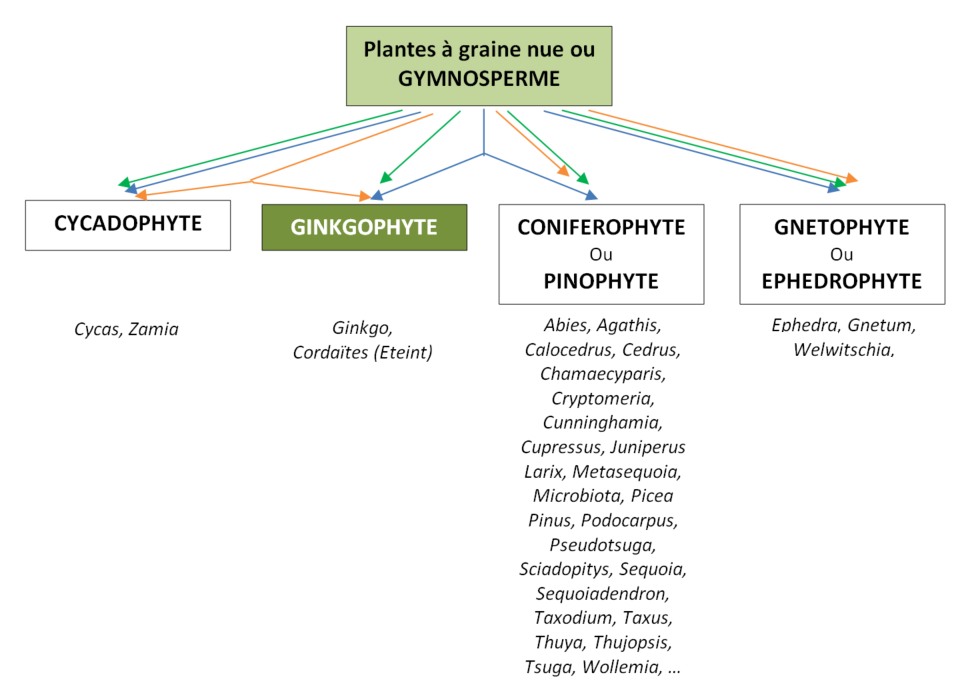
Les différents systèmes fléchés (orange, bleu ou vert) montrent les sous-embranchements possibles, sur base d’observations distinctes. Tantôt, le Ginkgo observe des similitudes avec les Cycas, tantôt avec les conifères. Ainsi, certains botanistes préfèrent les distinguer complètement, car il présente aussi des différences fondamentales avec ces deux autres groupes. L’objet qui nous occupe n’est pas de prendre parti ou de préciser les similitudes ou différences. Ce que nous pouvons affirmer, en tenant compte de cette qualification, c’est que le Ginkgo n’est pas un arbre, comme le serait le chêne ou l’érable. Par raccourci, et certains seront d’accord avec cette affirmation, le Ginkgo « est proche » des conifères.
A chacun son genre
Le Ginkgo est une plante agame, ou dioïque. On en rencontre donc des deux genres : mâle ou femelle. Dans la nature, la proportion est de 3 femelles pour 2 mâles.
.jpg)
Il est difficile de différencier les sujets mâles des femelles, à l'œil nu, si ce n'est par l’apparition des premières inflorescences, soit après 20ans.
Parmi les plantes gymnospermes, on ne parle pas de fruit. Ici, l’organe reproducteur femelle, l’ovule, est constitué d’un noyau, le nucelle, protégé par une membrane, ou un tissu différencié protecteur, le tégument. Les inflorescences femelles, quand à elles, sont constituées de simples pédoncules biovulés, verts, qui apparaissent à l’aisselle des feuilles. Elles se confondent, d’ailleurs, très facilement, avec les feuilles, au débourrage.
Les sujets femelles ont la mauvaise réputation de « sentir mauvais ».
Cela se produit, effectivement, pendant une courte période, lorsque l’ovule tombe par terre, alors que son tégument se décompose.
C’est l’acide butanoïque, contenu dans ce dernier, qui se libère et dégage cette odeur de rance. Le souci devient majeur, principalement avec des sujets d’âge mûr, souvent plus de 30 ans. D’ici là, il est plutôt attrayant de pouvoir profiter de la magnificence d’un Ginkgo, mâle ou femelle, dans son jardin. Le cas échéant, la récolte complète des ovules mûrs résoudra le souci et pourra ravir un producteur horticole.
Au Japon, on l’appelle aussi « l’arbre du grand-père et du petit fils », car celui qui le plante ne le voit jamais « fructifier ». Lorsqu’il est planté, il devient, d’après la légende, la promesse d’une lignée immortelle.
Les sujets mâles, quant à eux, portent des cônes, ou plutôt des chatons cylindriques pendants, à l’extrémité des rameaux courts, semblables à ceux des autres familles de conifères.
Les premiers organes reproducteurs apparaissant généralement sur des plantes matures, il est plutôt incertain de se fier à un quelconque discours, pour acheter un jeune plant mâle ou femelle, issu d’un semis. Il faut y préférer un sujet greffé ou bouturé, pour lequel il est aisé de tracer l’origine.
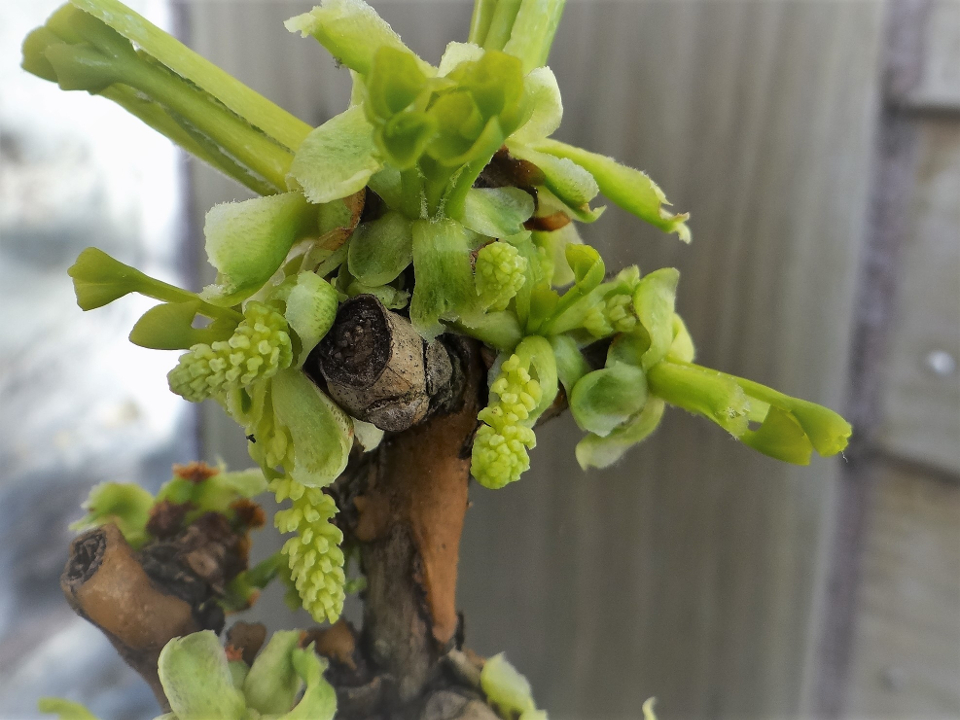
Un indice pourrait cependant aider dans la reconnaissance des individus, mais reste peu fiable.
Les mâles perdent leur feuilles une quinzaine de jours plus tôt que les femelles et ils sont de forme plus pyramidale et élancée. On pourrait alors identifier des sujets qui se trouvent à proximité, dans des conditions identiques.
Une longévité peu commune
Apparu sur terre dans la nuit des temps, le Ginkgo, aujourd'hui, est un genre monotypique, seul survivant de la famille des Ginkgoaceae. Il y a 270 millions d’années, cette famille était riche de 18 membres. Depuis, elle s’est profondément réduite, et seul le Ginkgo est arrivé jusqu’à nous.
Il est considéré, en Europe, comme un « fossile vivant ». Longtemps, il a été connu sous forme fossile uniquement. On estime, peut-être à tord, qu’il n’a plus évolué depuis 51 millions d’années. Les fossiles du jurassique montrent des différences, comme des feuilles multilobées alors que les plus récents présentent des feuilles proches du Ginkgo que nous connaissons aujourd’hui, à deux lobes marqués ou presqu’entière. Pourtant, si on étudie de près les Ginkgos issus d’un même semis, On retrouve, éventuellement, ces différences d’un sujet à l’autre. Par exemple, les variétés ‘Landliebe’ ou ‘Mephisto’ présentent des feuilles multilobées qui rappellent celles des plus vieux fossiles trouvés. Ces variétés ont été sélectionnées dans des semis.
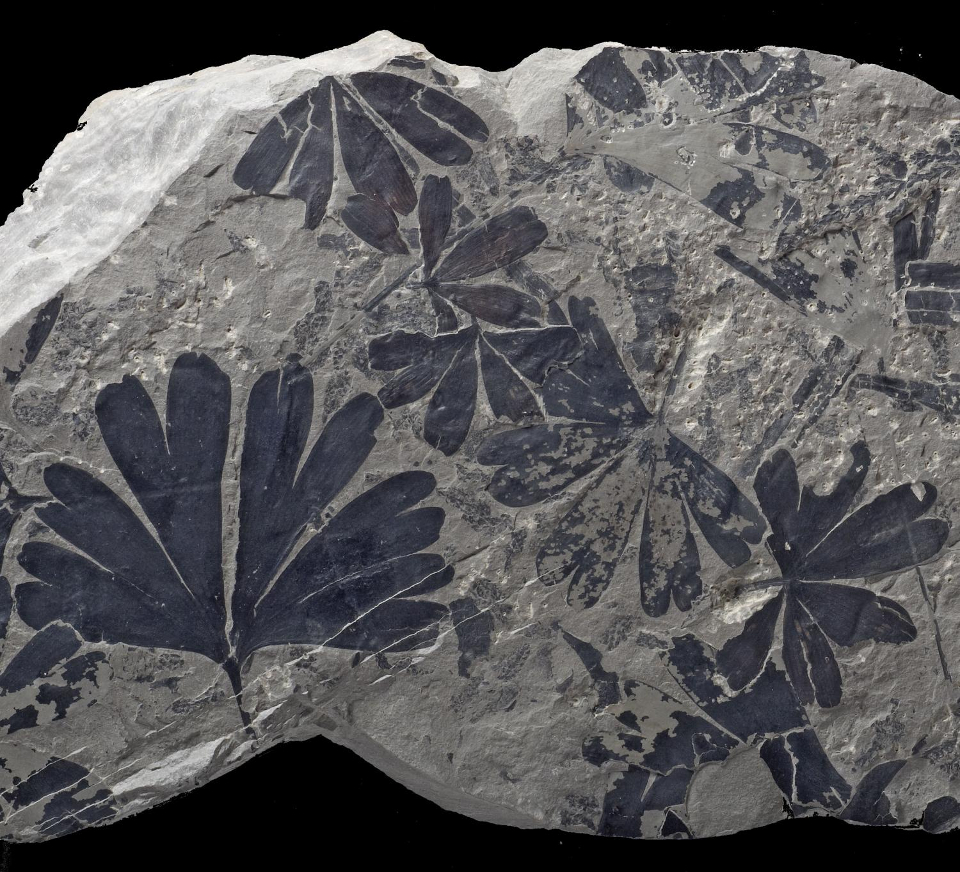
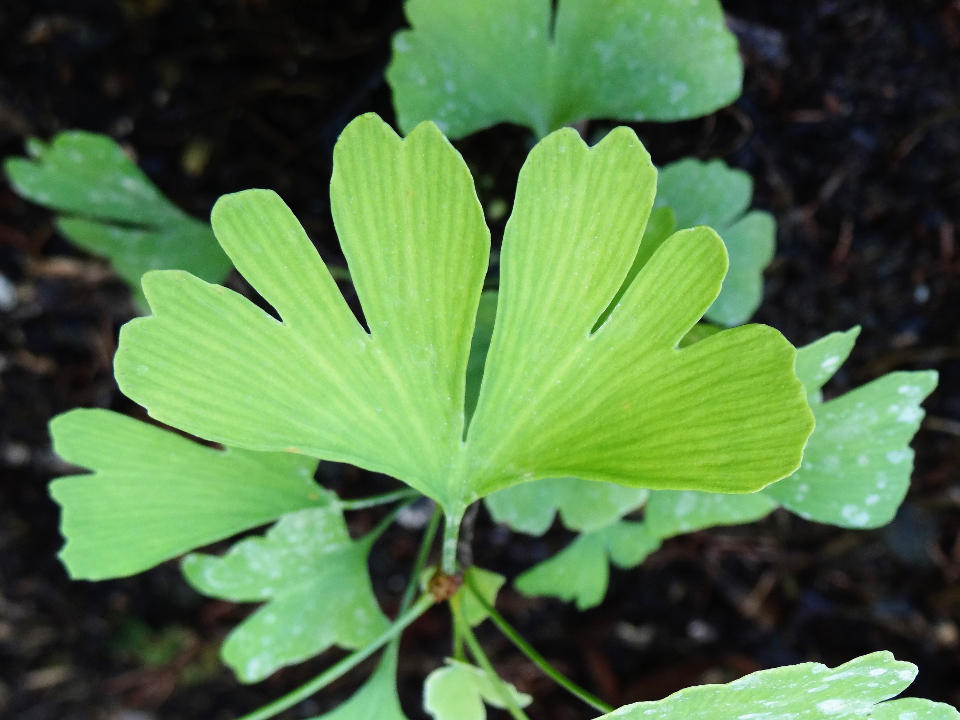
Crédit photo: Stephen McLoughlin Ginkgo biloba 'Landliebe'
.jpg)
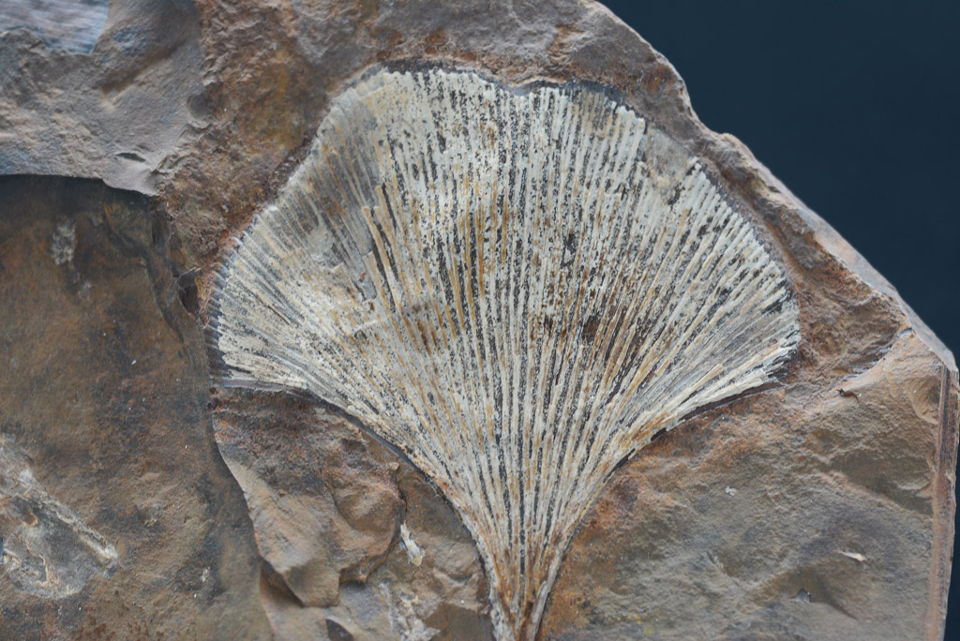
Ginkgo biloba Crédit photo : Carionmineraux
La forêt naturelle primaire où on rencontre des Ginkgos, se situe dans les monts Dalou, dont le point culminant flirte avec les 2.250m, dans la province de Guizhou, au sud ouest de la Chine. Le climat y est subtropical, chaud et humide ; le sol calcaire. Il pousse parfois dans des conditions difficiles, à même la roche, à flanc de montagne.
Outre les ‘Ginkgo biloba’, ces fragments de forêt primaire recèlent de beaux échantillons de plantes différentes à l'état sauvage et originel, comme les Metasequoia, Liquidambar, Cunninghamia, Cornus, Davidia, Glyptostrobus, Keteleeria, Taiwania, Nyssa, Carya, et bien d’autres.
On y rencontre des Ginkgos de 350 à 900 ans, voire même jusqu’à 1250 ans, à faire pâlir les plus vieux chênes ou Sequoiadendron de la planète.
Autour des temples, en Chine et au Japon, il n’est pas rare de rencontrer des vieux sujets millénaires. C’est le cas au Temple bouddhiste Gu Guanyin dans les Monts Zhongnan en Chine, où un impressionnant Ginkgo de 1400 ans s’épanouit dans la cour. Il attire les foules du pays entier, en automne, avec son tapis de feuilles d’or par millier ; une façon chinoise de fêter l’automne.
En réalité, le Ginkgo est planté, par les moines, depuis les années 1.100 avant Jésus-Christ. Ils l’apprécient pour ses belles qualités esthétiques, et médicinales ; mais surtout, les légendes lui prêtent un rôle protecteur.
Une résistance à toute épreuve
Attaques naturelles :
Dans sa forêt originelle, l'environnement est hostile, ponctué de roches calcaires affleurantes et soumis à des séismes récurrents. On le rencontre régulièrement à flanc de crevasse, poussant à même la roche, exposé en plein soleil.
Lorsqu'il est blessé, il modifie son métabolisme afin de survivre. C'est ainsi qu'il développe notamment les "chi-chi", des racines aériennes. Ces excroissances sont, de façon erronée, associées à l'âge de l'arbre, mais il n'en est rien. Il s'agit d'un mode de survie et apparait uniquement, éventuellement, lorsque le sujet est mis en péril.
Il peut également développer plusieurs troncs, côte à côte, afin de puiser davantage de ressources dans un sol même très pauvre.
Il modifie volontiers l'orientation de ses branches ou le développement de ses feuilles. C'est ainsi que sur un même sujet, on rencontre des branches maitresses aussi bien verticales qu'horizontales, voire obliques, ou des feuilles de plusieurs types : tubulaires, atrophiées, planes, entières ou multilobées.
.jpg)
Il suffit d’observer les différents sujets de Ginkgo biloba ‘Pendula’ du jardin botanique de Nancy, tous issus de la même sélection. Ils proposent des ports bien différents.
.jpg)
.jpg)
Il résiste mieux, que toute autre plante, aux champignons, maladies et parasites. Naturellement, le Ginkgo détecte, via de nombreux capteurs, ses indésirables potentiellement dangereux, et produit les substances chimiques nécessaires à les éradiquer. C’est en voulant se nourrir des feuilles ou d’autres parties de la plante, que les parasites ingurgitent les substances fatales. Le signal est donné et dès lors, très peu se risquent à « consommer » du Ginkgo.
De plus, le Ginkgo sait s’allier de partenaires efficaces. Une pharmacologue française de Tours a découvert, que les feuilles de ginkgo, sont partiellement recouvertes d’une forme d’algue archaïque, qui prendrait le relais de la photosynthèse, lorsque les cellules même des feuilles sont détruites. Ce processus permet ainsi la survie de l’arbre, lui donne la possibilité de tenir jusqu’à la saison suivante et de former de nouvelles feuilles.
Attaques humaines :
Le Ginkgo biloba s'adapte à tout, même à la pollution de nos villes modernes, atmosphère dans laquelle il continue à se développer parfaitement, alors que beaucoup d'autres arbres ou arbustes affichent une grise mine.
C'est aussi le premier arbre à reprendre son cycle végétatif, en 1946, après l'explosion nucléaire à Hiroshima ; alors que 337 autres espèces d’arbre n’y résistent pas. Un sujet emblématique est retrouvé parfaitement sein à 1km de l'épicentre, adossé aux ruines d'un temple. Le temple a été reconstruit autour de ce survivant. Des études ont suivi cet événement, démontrant la grande résistance de cette espèce, aux radiations. Les traces de contaminations étant les plus faibles chez le Ginkgo.
Il résiste également très bien au feu. Il sécrète une forme de caoutchouc, qui enveloppe l’entièreté de son écorce, et l’empêche ainsi de brûler. Un temple japonais, a survécu en 1923 à un incendie. Il était protégé par un alignement de Ginkgo qui a arrêté la progression du feu.
Le Ginkgo et ses vertus
La médecine traditionnelle chinoise, vieille de 5000 ans, l’utilise en consommant ses noyaux ovulaires grillés ou bouillis et ses feuilles séchées en infusion. Elle lui prête de nombreuses vertus déduites de ses caractéristiques observées, telles que la résistance ou la longévité.
Par extrapolation on lui confère de multiples pouvoirs :
- Des effets antioxydants (Il ralentirait la formation de cellules cancéreuses et la production de molécules inflammatoires),
- Il améliorerait la circulation sanguine (La fluidité sanguine réduirait le risque d’AVC, ainsi que les migraines, puisque le cerveau serait mieux irrigué),
- Il favoriserait la respiration et améliorerait l’immunité (Il combattrait donc l’asthme),
- Il améliorerait les qualités auditives et préviendrait les acouphènes,
- Il améliorerait les connexions neuronales et donc la mémoire (il bloquerait la formation des enzymes responsables de la maladie d’Alzheimer).
Même si des études scientifiques montrent que son potentiel est réel, isoler et utiliser les substances actives reste un casse tête.
Au XXème siècle on extrait les ginkgolides, notamment des feuilles, pour les introduire dans les compositions pharmaceutiques, pouvant ainsi répondre à un nombre croissant de pathologies propres à l’homme moderne. La réelle problématique, est que nous ne sommes encore certains de rien. Une plante comme le ginkgo contient plus de 10 000 substances actives et nous sommes bien loin de les connaitre, de pouvoir les extraire et encore moins de les utiliser à bon escient. Se soigner par les fruits ou par les feuilles de Ginkgo demeure largement empirique et difficilement contrôlable.
Extraire les ginkgolides relève d’un processus industriel, mettant en scène de nombreux produits dangereux comme l’acétone ou l’éthanol : Ils sont ensuite éliminés avant de les intégrer dans des préparations, mais quand même.
On pourrait dire encore aujourd’hui, comme il y a bien longtemps, que la force de l’esprit est bien supérieure à celle du corps. En gardant en tête toute la symbolique de l’arbre, et en absorbant ses substances, on s’en trouvera certainement spirituellement mieux.
En Europe

Source: soyinfo Center
Le Ginkgo biloba a été découvert vers 1690 par Englebert Kaempfer, un botaniste allemand, qui en donne une première description scientifique dans son livre "Amoenitatum exoticarum' en 1712. Il propose le nom Ginkgo sur base de son nom Japonais « Gin Yyo » qui signifie « patte de canard » en regard de la forme de sa feuille.
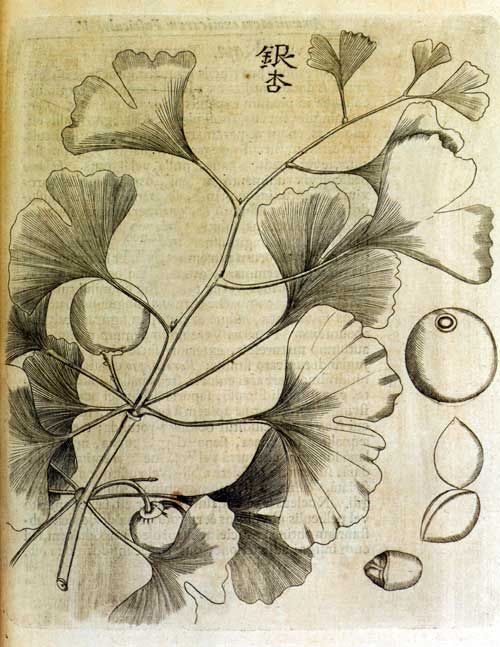
Illustration de Kaempfer dans « Amoenitatum exoticarum »
Les Chinois l’appellent « Yin (argent) Hing (Abricot) » d’où est tirée une de ses appellations françaises : l’abricotier d’argent. On l’appelle, plus communément « arbre aux 40 écus », montant exorbitant qu’avait dépensé un riche collectionneur de Paris, M. de Pétigny, vers 1780, pour obtenir un pot de cinq de ces sujets. On le rencontre également, par extrapolation, sous le nom d’ « arbre aux mille écus », en référence au tapis de feuille d’or, qu’on peut contempler à son pied, en automne.
.jpg)
L’« arbre des Pagodes » est encore utilisé pour le dénommer.
Les moines bouddhistes plantaient ces arbres vénérés autour de leurs temples et pagodes, afin d’écarter le feu. Au XIXème siècle, on l’appelait « noyer du Japon ».
Le premier arbre est planté en Europe à Utrecht, dans le « Oude Hortus », en 1735, d’un semis réalisé en 1927, à l’université même. Il apparait en 1754, en Angleterre, où il est cultivé à l’école botanique Gordon, et ensuite planté à Kew Garden en 1762.
En 1771, Linné, dans sa nomenclature binominale ajoute le genre 'biloba' en référence à ses feuilles généralement et particulièrement bilobées. Ce nom est officiellement reconnu depuis et l'appellation exacte est "Ginkgo biloba L.", L. référant à Karl von Linné lui-même, cet éminent botaniste suédois.
Le premier Ginkgo en France, est celui planté en 1788, 3 rue du Carré-du-roi à Montpellier. C’est Antoine Gouan, adjoint en botanique à l’académie de la ville, qui le reçoit d’Auguste Broussonnet, un éminent scientifique et politicien local, installé à Londres. Il s’agit d’un présent offert par Sir Joseph Banks, un naturaliste britannique qui participe au premier voyage autour du monde de James Cook. De cet arbre, sont extraites plusieurs marcottes, en 1795. Une est offerte aux jardins des plantes de Montpellier et une autre à celui de Paris. Ces arbres mâles produisent leurs premiers cônes en 1812, ce qui permet de déterminer leur genre.
Ces arbres sont toujours vivants.
En 1794, l'Angleterre voit « fleurir » son premier Ginkgo et en 1876 Darwin parle d'eux en "fossiles vivants".
____________________________________________________________________________________________________________________
Essai d’un recensement des plus vieux Ginkgos d’Europe au XVIIIème siècle.
NL-Utrect – De oude Hortus – 1735 – Mâle < semis en 1727 en provenance d’Asie (1er Ginkgo d’Europe)
I – Padoue – Jardin botanique de l’Université de Padoue- porte Nord – 1750 - mâle avec une branche femelle greffée< semis en provenance d’Asie
B- Geetbets – 37 Dorpsstraat à côté de l’église – 1753 – femelle < semis en provenance d’Asie – 20,5m
D – Weinheim – Schlosspark – 1758 – 20m de haut.
GB- Londres - Kew Garden – 1762 – Mâle < semis en 1754 en provenance d’Asie
B - Château de Dumon à Tournai – 1766 – 31m
I – Milan – Jardin botanique di Brera – 1775 – 21m
A - Schönbrunn – 1781 - mâle avec une branche femelle greffée < Pied reçu d’Asie via l’Angleterre
I – Pise – Jardin botanique de Pise – 1787 – mâle < semis en provenance d’Asie – planté par Giorgio Santi, naturaliste botaniste.
NL- Leiden – Hortus botanicus – 1788 – mâle avec une branche femelle greffée
F - Montpellier – 3 rue du carré du roi – 1788 – mâle < Pied reçu d’Asie via l’Angleterre (GBfr1)
CH - Genève – Bourdigny – 1790 – femelle < Pied reçu d’Asie via l’Angleterre et la France, envoyé par Thomas Blackie (jardinier paysagiste en charge du château de Bagatelle) GBsu1- présumé mort – non répertorié sur la carte des arbres de Genève.
F - Montpellier – Jardin des plantes – 1795 – mâle avec une branche femelle greffée(GBsu1) < marcotte de GBfr1
F- Paris – jardin des plantes – 1795 – mâle < marcotte de GBfr1
Bibliographie
Cindy Q. Tang « The Subtropical Vegetation of Southwestern China, Plant Distribution, Diversity and Ecology » , Springer 2015.
Gymnosperm (naked seeds plant) : structure and development par V.P. Singh
the first botanical gardens in geneva - studies in the history of gardens and designed landscapes: sigrist & bungener
Bibliothèque universelle de Genève Nouvelle série, volumes 5 et 6- Bulletin scientifique - Sur l’origine des pieds de Ginkgo femelles qui existent en Europe1836
Defense Mechanisms in Leaves and Fruit of Trees to Fungal Infection - J. E. Adaskaveg
Ginkgo et ginseng: de la poudre aux yeux ! – RTS TV